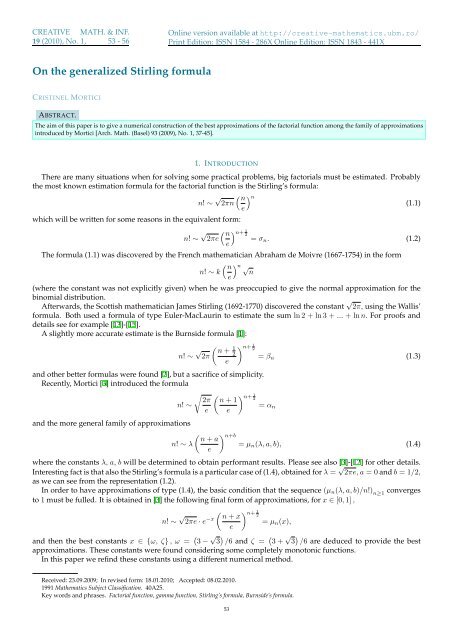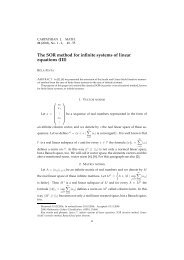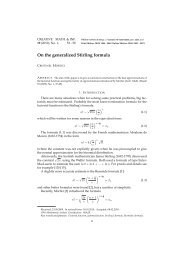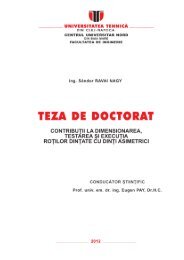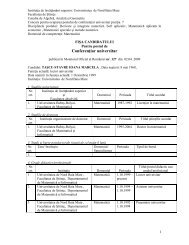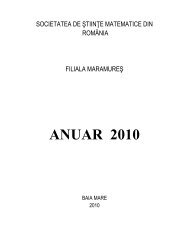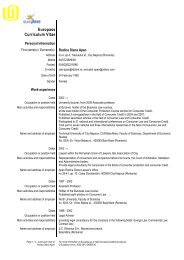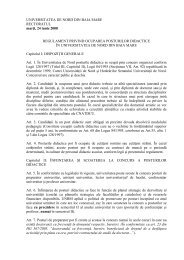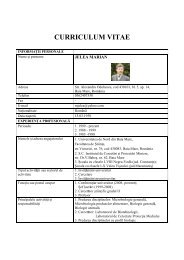On the generalized Stirling formula - Creative Math. and Inf.
On the generalized Stirling formula - Creative Math. and Inf.
On the generalized Stirling formula - Creative Math. and Inf.
Create successful ePaper yourself
Turn your PDF publications into a flip-book with our unique Google optimized e-Paper software.
CREATIVE MATH. & INF.19 (2010), No. 1, 53 - 56<strong>On</strong>line version available at http://creative-ma<strong>the</strong>matics.ubm.ro/Print Edition: ISSN 1584 - 286X <strong>On</strong>line Edition: ISSN 1843 - 441X<strong>On</strong> <strong>the</strong> <strong>generalized</strong> <strong>Stirling</strong> <strong>formula</strong>CRISTINEL MORTICIABSTRACT.The aim of this paper is to give a numerical construction of <strong>the</strong> best approximations of <strong>the</strong> factorial function among <strong>the</strong> family of approximationsintroduced by Mortici [Arch. <strong>Math</strong>. (Basel) 93 (2009), No. 1, 37-45].1. INTRODUCTIONThere are many situations when for solving some practical problems, big factorials must be estimated. Probably<strong>the</strong> most known estimation <strong>formula</strong> for <strong>the</strong> factorial function is <strong>the</strong> <strong>Stirling</strong>’s <strong>formula</strong>:n! ∼ √ ( n) n2πn(1.1)ewhich will be written for some reasons in <strong>the</strong> equivalent form:n! ∼ √ ( n) n+ 122πee= σ n . (1.2)The <strong>formula</strong> (1.1) was discovered by <strong>the</strong> French ma<strong>the</strong>matician Abraham de Moivre (1667-1754) in <strong>the</strong> form( n) n √n! ∼ k ne(where <strong>the</strong> constant was not explicitly given) when he was preoccupied to give <strong>the</strong> normal approximation for <strong>the</strong>binomial distribution.Afterwards, <strong>the</strong> Scottish ma<strong>the</strong>matician James <strong>Stirling</strong> (1692-1770) discovered <strong>the</strong> constant √ 2π, using <strong>the</strong> Wallis’<strong>formula</strong>. Both used a <strong>formula</strong> of type Euler-MacLaurin to estimate <strong>the</strong> sum ln 2 + ln 3 + ... + ln n. For proofs <strong>and</strong>details see for example [13]-[15].A slightly more accurate estimate is <strong>the</strong> Burnside <strong>formula</strong> [1]:n! ∼ √ 2π<strong>and</strong> o<strong>the</strong>r better <strong>formula</strong>s were found [2], but a sacrifice of simplicity.Recently, Mortici [3] introduced <strong>the</strong> <strong>formula</strong>( n +1)n+ 1 22= β n (1.3)e<strong>and</strong> <strong>the</strong> more general family of approximations√2πn! ∼e( n + 1e) n+ 12= αn( ) n+b n + an! ∼ λ= µ n (λ, a, b), (1.4)ewhere <strong>the</strong> constants λ, a, b will be determined to obtain performant results. Please see also [3]-[12] for o<strong>the</strong>r details.Interesting fact is that also <strong>the</strong> <strong>Stirling</strong>’s <strong>formula</strong> is a particular case of (1.4), obtained for λ = √ 2πe, a = 0 <strong>and</strong> b = 1/2,as we can see from <strong>the</strong> representation (1.2).In order to have approximations of type (1.4), <strong>the</strong> basic condition that <strong>the</strong> sequence (µ n (λ, a, b)/n!) n≥1convergesto 1 must be fulled. It is obtained in [3] <strong>the</strong> following final form of approximations, for x ∈ [0, 1] ,n! ∼ √ ( ) n+ 1n + x2πe · e −x 2= µn (x),e<strong>and</strong> <strong>the</strong>n <strong>the</strong> best constants x ∈ {ω, ζ} , ω = ( 3 − √ 3 ) /6 <strong>and</strong> ζ = ( 3 + √ 3 ) /6 are deduced to provide <strong>the</strong> bestapproximations. These constants were found considering some completely monotonic functions.In this paper we refind <strong>the</strong>se constants using a different numerical method.Received: 23.09.2009; In revised form: 18.01.2010; Accepted: 08.02.2010.1991 Ma<strong>the</strong>matics Subject Classification. 40A25.Key words <strong>and</strong> phrases. Factorial function, gamma function, <strong>Stirling</strong>’s <strong>formula</strong>, Burnside’s <strong>formula</strong>.53
54 C. Mortici2. THE RESULTSThe function µ n (x) is strictly increasing on [0, 1/2] <strong>and</strong> strictly decreasing on [1/2, 1] , becauseddx (ln µ n(x)) =12 − xx + n ,so a direct consequence is that µ n (0) < n! < µ n (1/2) > n! > µ n (1), orσ n < n! < β n > n! > α n . (2.5)By <strong>the</strong> inequalities (2.5) <strong>and</strong> by continuity arguments on <strong>the</strong> function µ n (x), it results that <strong>the</strong>re exists a sequence(w n ) n≥1⊂ (0, 1/2) such that µ n (w n ) = n!, which isn! = √ ( ) n+ 1n + wn22πe · e −wn e<strong>and</strong> <strong>the</strong>re exists a sequence (z n ) n≥1⊂ (1/2, 1) such that f(z n ) = n!, orn! = √ ( ) n+ 1n + zn22πe · e −zn .eAfter some numerical computations, we deduced that <strong>the</strong> sequences (w n ) n≥1<strong>and</strong> (z n ) n≥1are decreasing, so <strong>the</strong>y areconvergent to w = 0.21133..., respective to z = 0.78868... . Now we have obtained <strong>the</strong> following under-approximation<strong>and</strong> upper-approximation <strong>formula</strong>s for <strong>the</strong> factorial function:√2πe · e−0.21133...( n + 0.21133...e) n+ 12< n!
<strong>On</strong> <strong>the</strong> <strong>generalized</strong> <strong>Stirling</strong> <strong>formula</strong> 55REFERENCES[1] Burnside, W., A rapidly convergent series for log N!, Messenger <strong>Math</strong>. 46 (1917), 157-159[2] Gosper, R. W., Decision procedure for indefinite hypergeometric summation, Proc. Natl. Acad. Sci. 75 (1978), 40–42[3] Mortici, C., An ultimate extremely accurate <strong>formula</strong> for approximation of <strong>the</strong> factorial function, Arch. <strong>Math</strong>. 93 (2009), No. 1, 37-45[4] Mortici, C., Product approximations via asymptotic integration, Amer. <strong>Math</strong>. Monthly 117 (2010),No. 5, 434-441[5] Mortici, C., New approximations of <strong>the</strong> gamma function in terms of <strong>the</strong> digamma function, Appl. <strong>Math</strong>. Lett. 23 (2010), No. 1, 97-100[6] Mortici, C., New sharp bounds for gamma <strong>and</strong> digamma functions, An. Ştiinţ. Univ. A. I. Cuza Iaşi Ser. N. Matem. 56, No. 2 (in press)[7] Mortici, C., Complete monotonic functions associated with gamma function <strong>and</strong> applications, Carpathian J. <strong>Math</strong>. 25 (2009), No. 2, 186-191[8] Mortici, C., Optimizing <strong>the</strong> rate of convergence in some new classes of sequences convergent to Euler’s constant, Anal. Appl. (Singap.) 8 (2010), No. 1,1-9[9] Mortici, C., Improved convergence towards <strong>generalized</strong> Euler-Mascheroni constant, Appl. <strong>Math</strong>. Comput. 215 (2010), 3443-3448[10] Mortici, C., A class of integral approximations for <strong>the</strong> factorial function, Comput. <strong>Math</strong>. Appl. (2010), DOI: 10.1016/j.camwa.2009.12.010[11] Mortici, C., Best estimates of <strong>the</strong> <strong>generalized</strong> <strong>Stirling</strong> <strong>formula</strong>, Appl. <strong>Math</strong>. Comput. 215 (2010), No. 11, 4044-4048[12] Mortici, C., <strong>On</strong> new sequences converging towards <strong>the</strong> Euler-Mascheroni constant, Comput. <strong>Math</strong>. Appl. (2010), DOI: 10.1016/j.camwa.2010.01.029[13] O’Connor, J. <strong>and</strong> Robertson, E. F., James <strong>Stirling</strong>, MacTutor History of Ma<strong>the</strong>matics Archive[14] Qin, X. <strong>and</strong> Su, Y.,Viscosity approximation methods for nonexpansive mappings in Banach spaces, Carpathian J. <strong>Math</strong>. 22 (2006), No. 1-2, 163-172[15] <strong>Stirling</strong>, J., Methodus differentialis, sive tractatus de summation et interpolation serierum infinitarium, London, 1730. English translation by J. Holliday,The Differential Method: A Treatise of <strong>the</strong> Summation <strong>and</strong> Interpolation of <strong>Inf</strong>inite SeriesDEPARTMENT OF MATHEMATICSVALAHIA UNIVERSITY OF TÂRGOVIŞTEUNIRII 18, 130082 TÂRGOVIŞTEE-mail address: cmortici@valahia.roE-mail address: cristinelmortici@yahoo.com


